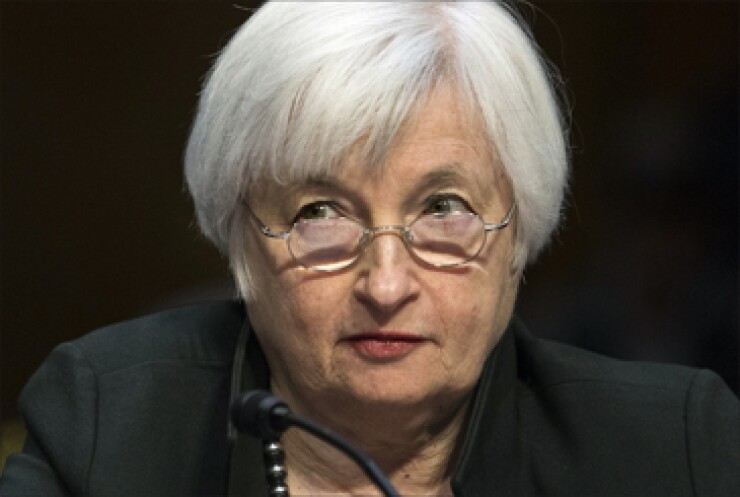
WASHINGTON — The Federal Open Markets Committee on Wednesday voted to raise federal interest rates from nearly zero for the first time since 2008, meeting market expectations but ushering in a new and uncertain normal for the financial services industry.
The Committee voted to raise rates 25 basis points — to between 0.25% and .5% — with 11 voting in favor. Two FOMC members apparently preferred to keep rates at the current zero lower bound, as indicated by their so-called "dot plot" of preferred rate levels. Those members did not dissent the decision, however.
The committee approved the historic hike despite slight downward projections for inflation in 2015 and 2016, perhaps encouraged by slightly increased projections for GDP in 2016, up to 2.4% from 2.3%.
Yellen said that the committee decided to raise interest rates because of gains in the labor market in 2015, the expectation that headwinds from cheap energy prices and imports will dissipate over time, and that economic growth will continue "to expand at a moderate pace".
"The stance of monetary policy remains accommodative after this increase, thereby supporting further improvement in labor market conditions and a return to 2% inflation," Yellen said. "The committee expects that economic conditions will evolve in a manner that will warrant only gradual increases in the federal funds rate; the federal funds rate is likely to remain, for some time, below levels that are expected to prevail in the longer run."
The committee's expectation for the timing of the federal funds rate's gradual rise was roughly in line with market expectations. Seven of the committee members preferred a rate of between 1.25% and 1.5% by the end of 2016, though another seven members envisioned lower rates. Committee members had a far wider spread of opinions for year-end rates in 2017, with suggestions ranging from just under 2% to 3.5%. Twelve of the seventeen members expected a longer-run rate of between 3.25% and 3.5%.
The announcement was not unexpected. The day before the FOMC made its announcement, interest rate futures markets were estimating a roughly 80% probability that the Fed would raise rates. Yellen and other FOMC members made strong indications in speeches leading up to the meeting that the committee's longstanding conditions for raising rates — a stronger labor market and more signs of inflation — appeared to be materializing.
Banks have different opinions on whether the rate increase will help or hurt mortgage loan demand.
Bob Braswell, CEO of Carolina Bank Holdings, said that any chilling effect from rate hikes "depends on pace of increases," where a sudden or haphazard series of hikes could affect markets but a steadier increase could provide "opportunities" for bankers.
Scott Anderson, chief economist with Bank of the West, is more pessimistic, saying that there will be some chilling effect in loan demand, particularly for big consumer purchases, but growth will probably remain moderate next year.
"Mortgage rates will start moving higher. That's going to take some of the expansion potential away from 2016," Anderson said. "Some of these big ticket items, like autos and houses, you might see relatively bigger impacts. [Borrowers] are used to very low interest rates."
Lawrence Yun, chief economist for the National Association of Realtors, said that increasing rates — especially by such a trivial amount — could act as a stimulant to the economy by signaling to the markets that the Fed thinks it is growing at a steady and reliable pace and can handle a slightly tighter monetary policy. Anyone who was going to borrow in 2016 isn't going to defer because the Fed raised rates by 25 basis points, he said.
"The raising of short-term rates could be more of a confidence play to the market — it provides a signal that the economy is strengthening, and to the degree that the Federal Reserve is providing [that signal] and the lenders believe that, it may actually provide more lending opportunity for the banks," Yun said. "As a borrower, even for the short-term borrower, what difference does it really make whether one is borrowing at 0.1% or 0.2%, when the Fed Funds Rate is historically at 3.3% or 3.5%?"
Part of the question for banks is not only whether rates go up, but also what methods they use and how those methods interact with regulators' new regulatory capital and leverage requirements.
As expected, the FOMC voted to raise its interest rates on required and excess reserves to 0.5% as its primary means of raising short-term rates. It also instructed the Open Market desk at the Federal Reserve Banks of New York to execute overnight reverse repurchase operations, at an offering rate of 0.25%. The FOMC also voted to increase the discount rate by 0.25% to 1%. All of these changes will be effective Dec. 17.
The Fed opted not to change its policy of "rolling over" its holdings of longer-term securities when they reach maturity and reinvesting principal payments from its holdings of agency debt and mortgage-backed securities, "and anticipates doing so until normalization of the federal funds rate is well under way," Yellen said.





